The American Institute of Architects (AIA) and its Committee on the Environment (COTE) have selected the top 10 examples of sustainable architecture and ecological design projects that protect and enhance the environment. The projects will be honored at the AIA 2015 National Convention and Design Exposition in Atlanta.
The COTE Top Ten Awards program, now in its 19th year, is the profession's most rigorous recognition program for sustainable design excellence. The program celebrates projects that are the result of a thoroughly integrated approach to architecture, natural systems and technology. They make a positive contribution to their communities, improve comfort for building occupants and reduce environmental impacts through strategies such as reuse of existing structures, connection to transit systems, low-impact and regenerative site development, energy and water conservation, use of sustainable or renewable construction materials, and design that improves indoor air quality.
The Bullitt Center; Seattle
The Miller Hull Partnership
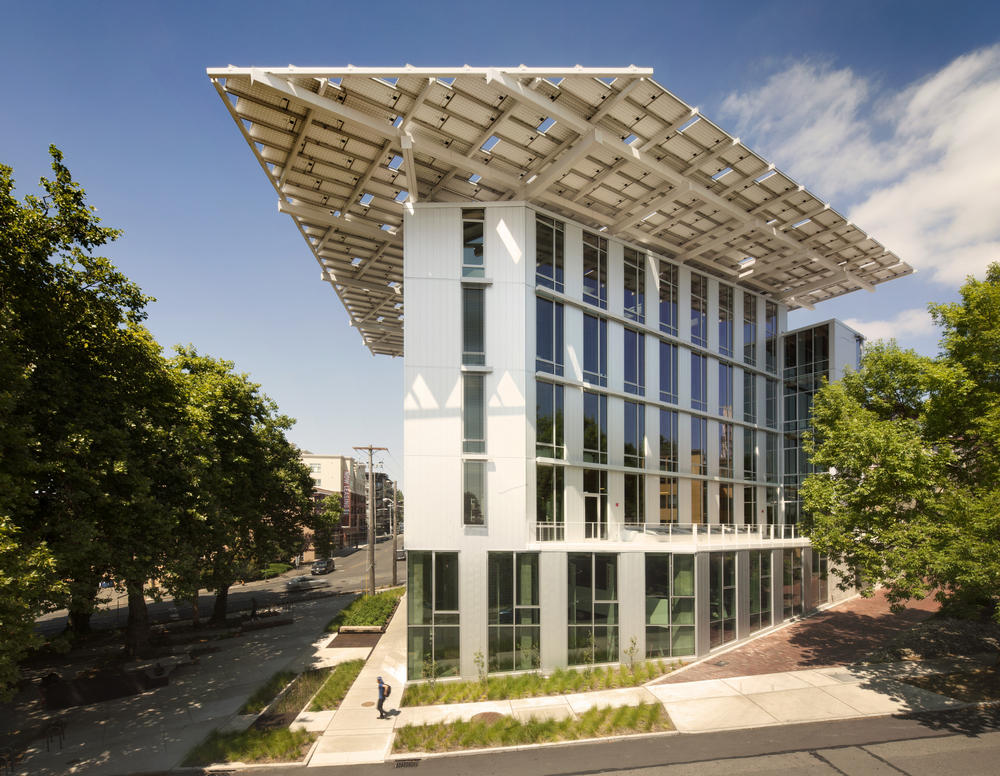 Image: Nic Lehoux
Image: Nic Lehoux
The Bullitt Center is a high performance urban office building demonstrating a commercially-viable structure with essentially no environmental footprint is possible; it is the largest certified Living Building. Performance metrics drove building design with every material and system in the self-sustaining six-story, 52,000-square-foot office building evaluated toward the goal of net zero energy, water, and waste—resulting in an unprecedented Energy Use Intensity (EUI) of 10kbtu/sf/yr. Sustainable design moves responding to regional context include operable floor-to-ceiling windows for daylight and fresh air, heavy-timber framing, a transparent ‘irresistible stair’ with dramatic views, and overhanging roof characteristic of Northwest design vernacular. A new paradigm for design, the building serves as a living laboratory for high-performance architecture and sustainability education seeking to influence the way society views the relationship of a building to its environment.
CANMET Materials Technology Laboratory; Hammilton, Ontario, Canada
Diamond Schmitt
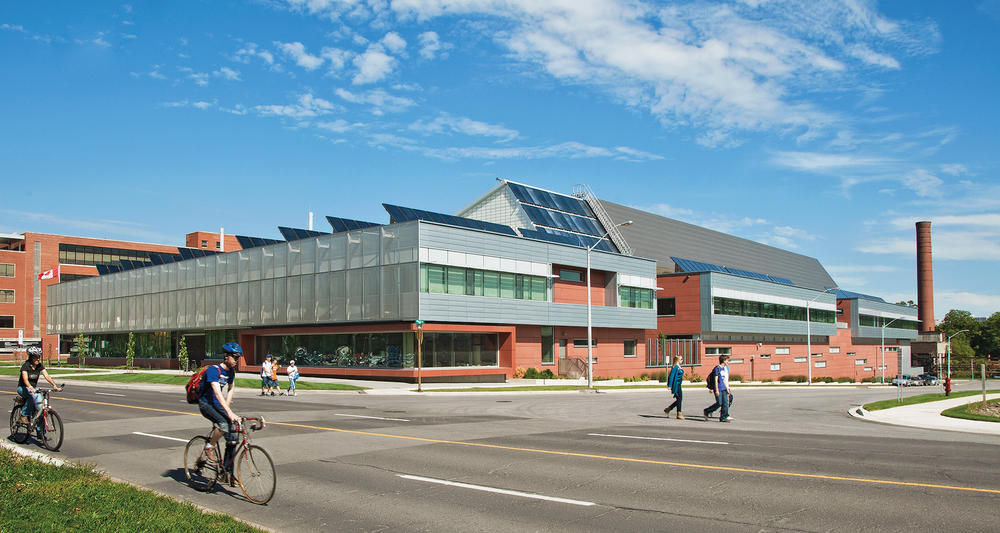 Image: Elizabeth Gyde
Image: Elizabeth Gyde
This 174,300-sf lab and support office space incorporates a complex industrial program of pilot scale casting, rolling and welding, corrosion, and mechanical testing alongside microstructure evaluations and radiation testing. With over 800 customized pieces of equipment in addition to generic lab equipment CANMET is a complex energy use intensive building. The pursuit of LEED Platinum triggered a comprehensive Integrated Design Process (IDP), which was pivotal to the resulting design. A building charter targeted significant energy use reduction to exceed the 2030 Challenge and achieve a 70% energy use reduction, a goal that is particularly challenging for an industrial lab building.
Collaborative Life Sciences Building for OHSU, PSU & OSU; Portland, Ore.
SERA Architects
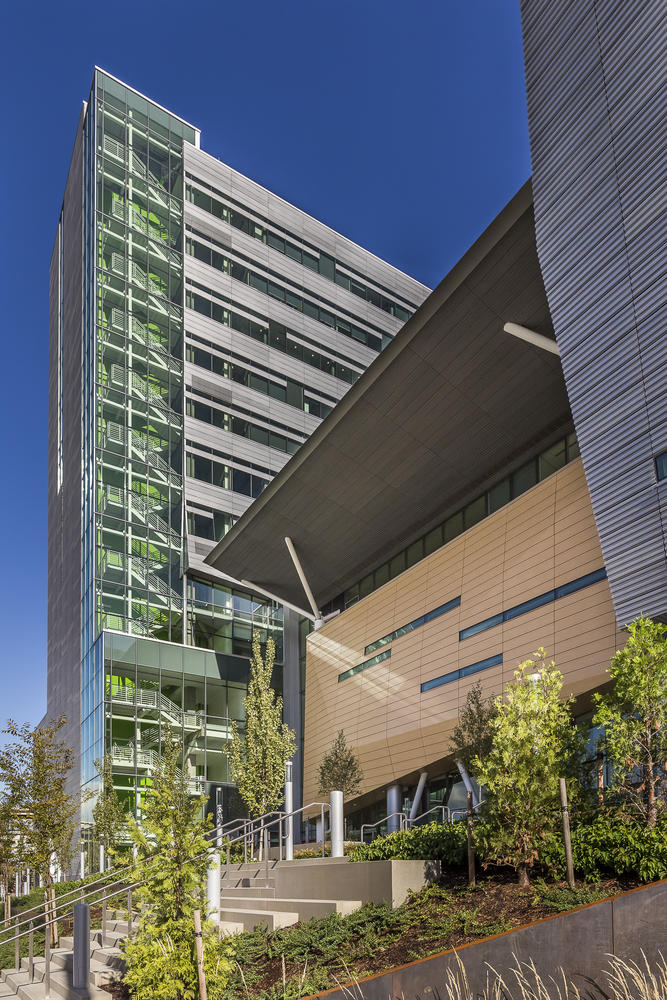 Image: Alene Davis Photography
Image: Alene Davis Photography
Oregon Health & Science University, Portland State University, and Oregon State University partnered to create a new allied health, academic, and research building. Located on a former brownfield site constrained by adjacent roadway and bridge construction, the building is conceived as an innovative model of interdisciplinary health sciences education, research, and education. Interior glazed walls foster “research and teaching on display,” allowing occupants and pedestrians to view the activity in labs and classrooms.
The atrium offers dynamic connections between program elements through connecting bridges and informal study areas for students. As one of only two projects in the U.S. over a half million square feet that has been certified Platinum under the LEED NC v2009 rating system, this project incorporates a number of sustainable design innovations including: transformation of an existing brownfield, light pollution reduction, stormwater management, ecoroofs to reduce stormwater runoff, nonpotable water for toilet flushing, atrium heat recovery, and low ventilation fume hoods.
E+ // 226-232 Highland Street Townhouses; Boston
Interface Studio Architects (ISA) and Urbanica Design
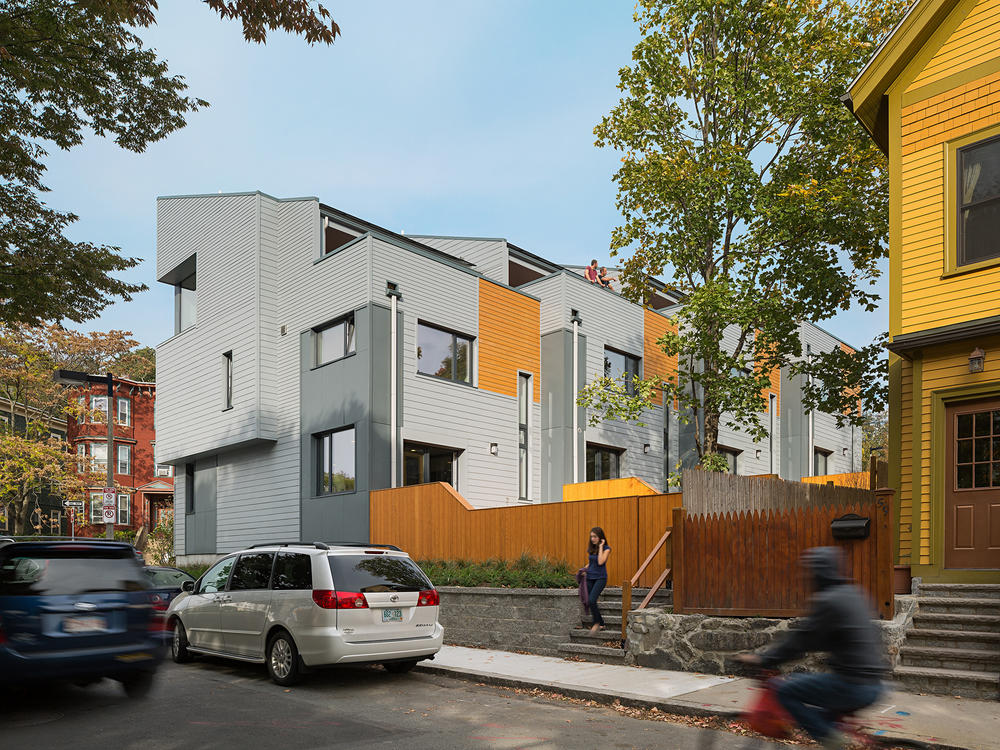 Image: Sam Oberter
Image: Sam Oberter
The project was conceived as a replicable prototype for family friendly, energy efficient, urban townhomes. Each unit is approximately 1850-square-feet, with flexible living areas, 3 bedrooms, and 2.5 bathrooms. The project was the first completed under the City of Boston’s Energy Plus (E+) Green Building Program, a pilot initiative to develop energy positive sustainable housing. The project team was chosen through a design competition organized by the Boston Redevelopment Authority (BRA) and the Department of Neighborhood Development. Incorporating both passive and active energy efficiency measures, the project has achieved HERS ratings between 6 and 9, and is certified LEED for Homes Platinum.
Hughes Warehouse Adaptive Reuse; San Antonio
Overland Partners
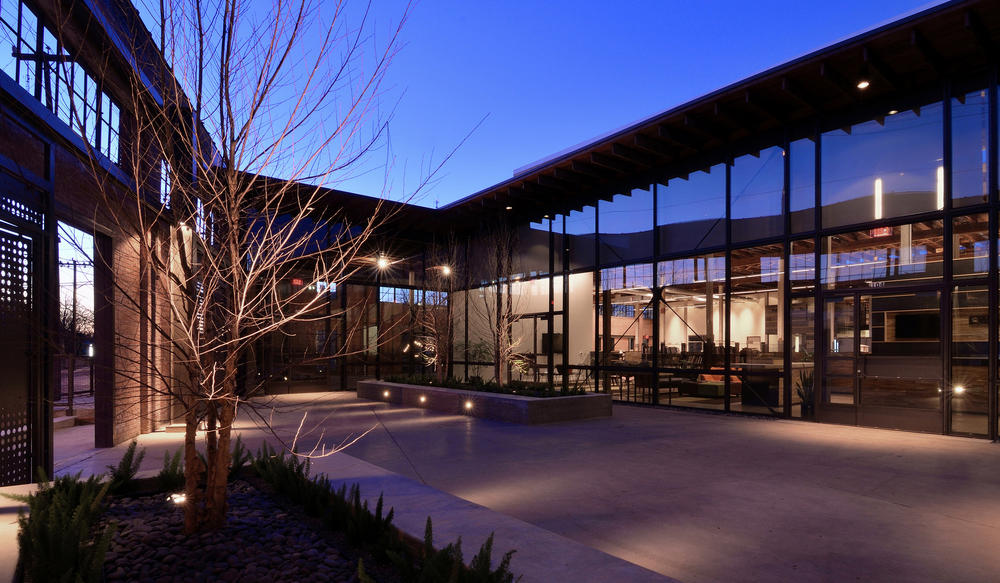 Image: AIA
Image: AIA
This adaptive reuse project transforms an early 20th century warehouse into an innovative but functional studio space. The balance between maintaining the historic integrity of the building and improving energy efficiency was critical for the nearly 100-year-old building. As a result, the design team focused on preserving the open plan space and leaving interventions light in order to maximize flexibility of the space for future users as well as to encourage collaboration amongst staff and minimize material usage, achieved through the elimination of private offices. Though it decreased leasable square footage, the project’s newly inserted courtyard became integral to the design, providing a place for public life, improving daylighting, and decreasing the amount of conditioned space.
Military Medical Hospital; San Antonio
RTKL
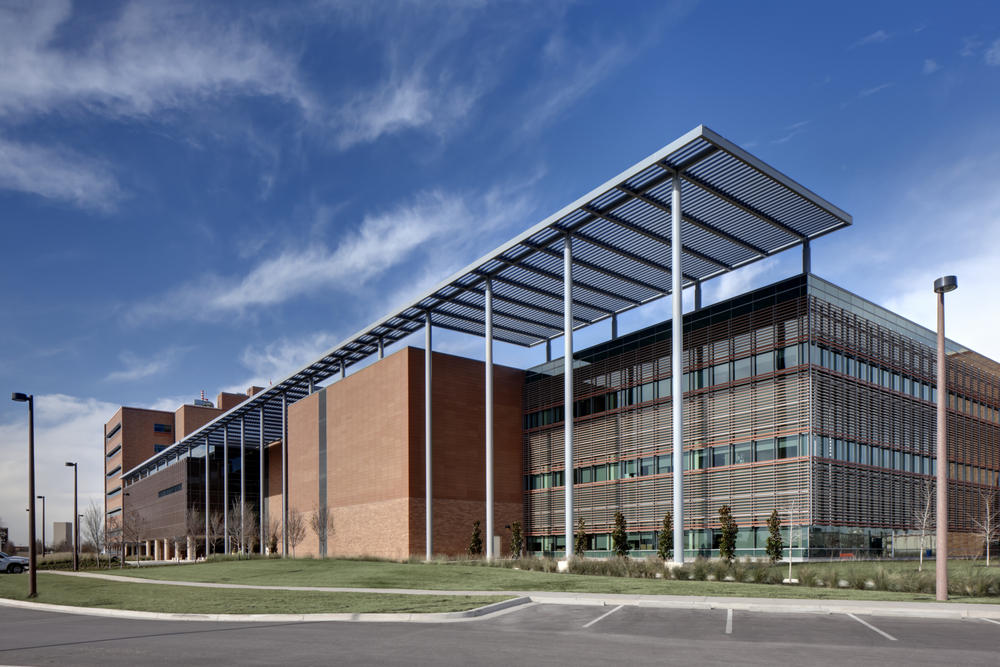 Image: AIA
Image: AIA
San Antonio Military Medical Center (SAMMC) is home to a world class burn treatment and recovery unit, and the design both accommodates this function and draws its architectural inspiration from it. A long trellis canopy spans the length of the south elevation, throwing dappled shade on the building and presenting the welcoming image of a large veranda. Under this umbrella, the footprint of the façade varies to break down the scale of a very long elevation while shading the building as the sun moves toward the west. Surfaces at the front edge have no fenestration, avoiding heat gain, while the surfaces at the back of the trellis are extensively glazed and shaded. These simple architectural gestures humanize the scale and image of the medical center while aiding environmental performance.
New Orleans BioInnovation Center (NOBIC); New Orleans
Eskew+Dumez+Ripple
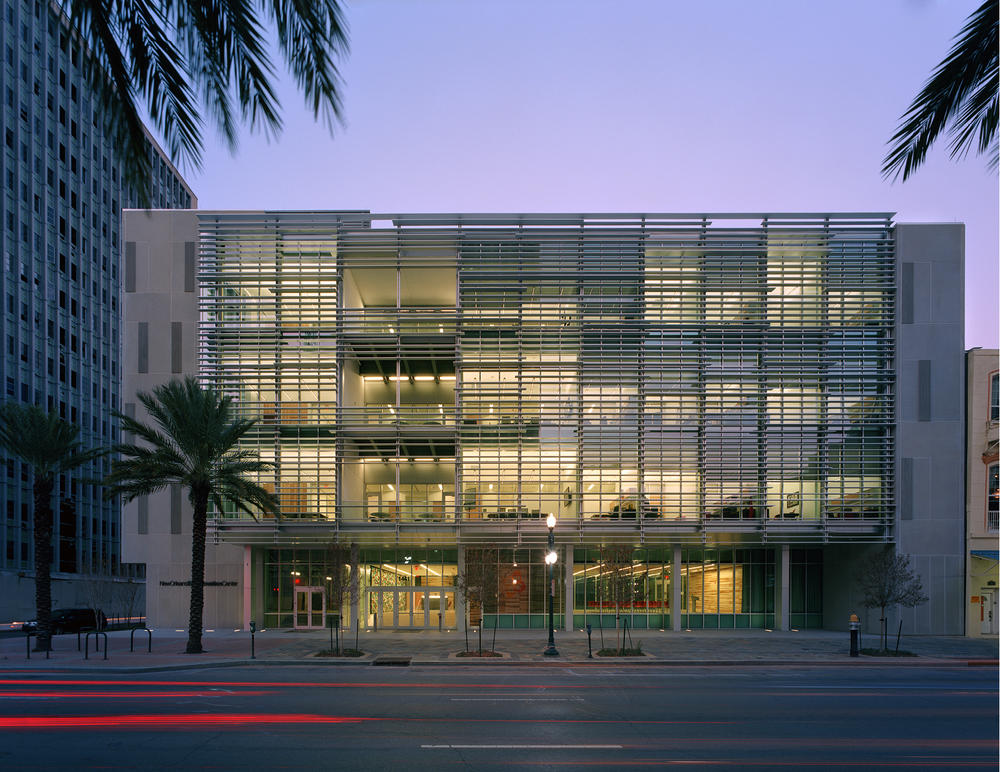 Image: Timothy Hursley
Image: Timothy Hursley
The NOBIC, a LEED Gold research facility serves as an incubator for biotech startups, helping ideas conceived locally to become local jobs and industries. The facility includes a flexible 100 person conferencing center, breakout spaces, and a 2,000-sqaure-foot café. The design reinterprets vernacular regional climate responsive strategies—the slatted shutter, the landscaped courtyard water feature, the sheltered porch—to provide a facility that is both of its place and of its time. The facility captures rainwater and diffuses it to plants and soils on site, and is supplemented by the AC condensate (up to 20,000 gallons per week), which provides all landscape irrigation on site.
Sweetwater Spectrum Community; Sonoma, Calif.
Leddy Maytum Stacy Architects
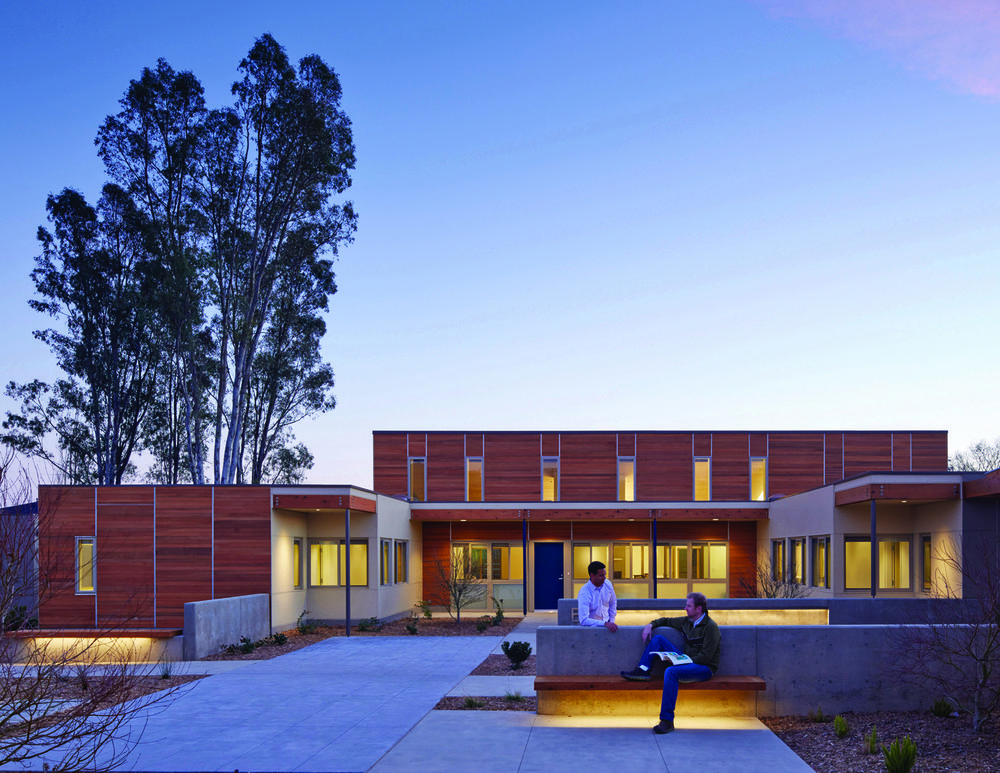 Image: Tim Griffith
Image: Tim Griffith
Sweetwater Spectrum is a new national model for supportive housing for adults with autism, offering life with purpose and dignity. The project includes four homes, a community center, therapy pools and urban farm. Practical sustainable design strategies promote health and wellness, reduce energy consumption, and offer multiple long term benefits to residents, staff, and the Sonoma community. The project is a Pacific Gas & Electric Zero Net Energy Pilot Project and exceeds the 2030 Commitment. A variety of passive and active strategies, including building orientation, high performance envelope, building integrated photovoltaic, and solar thermal panels reduce energy consumption by 88% from baseline.
Tassafaronga Village; Oakland, Calif.
David Baker Architects
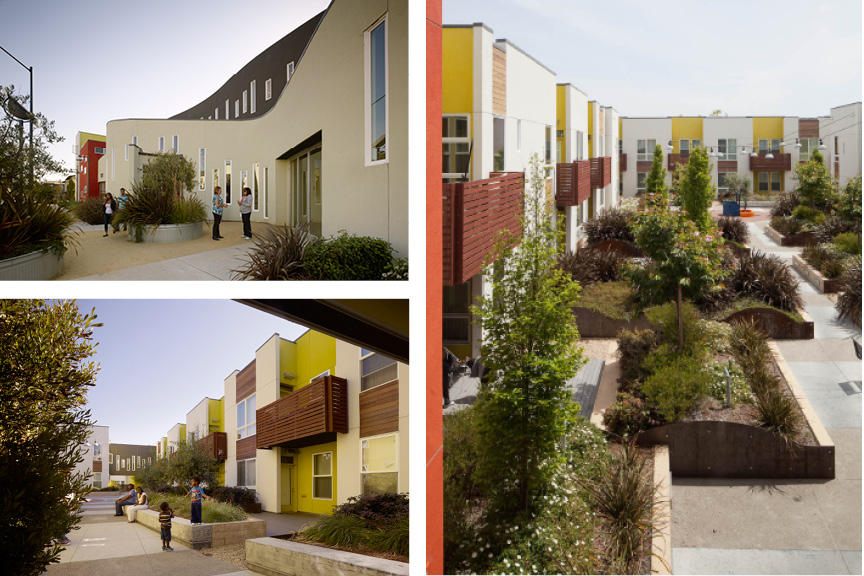 Image: Matthew Millman (left)/Bruce Damonte (right)
Image: Matthew Millman (left)/Bruce Damonte (right)
This project includes a 60 unit affordable apartment building, 77 affordable attached "townhouses" for rent (clustered in 13 buildings), and 20 supportive apartments with onsite medical clinic. Deep roof overhangs, fin walls, site plantings, and thoughtful window placement provide resilience against heat spikes, relieving high southern, and hot western sun. The building design provides comfortable daylight, views, and airflow by increasing the exposure in individual rooms and units. All rooms within each unit meet the standard for natural ventilation under ASHRAE 62.22007. A well-insulated thermal envelope and reduced infiltration allow improved comfort and protection from odors, noise, and other pollutants.
University Center - The New School; New York City
Skidmore, Owings & Merrill LLP
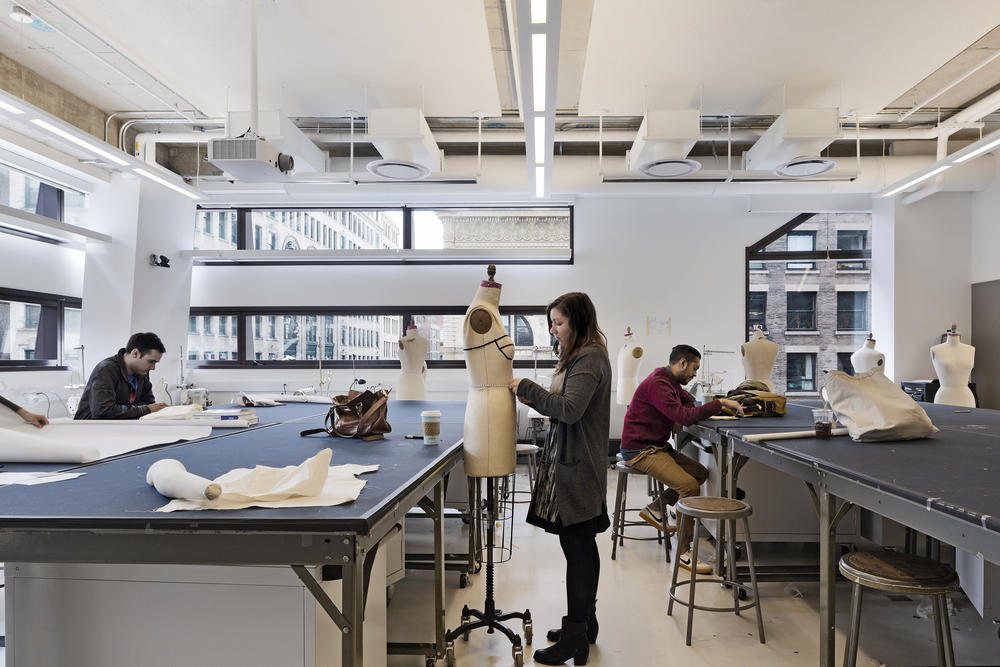 Image: James Ewing
Image: James Ewing
The LEED Gold building provides space for all aspects of a traditional campus, with 200,000 square feet of academic space on the first seven floors and 150,000 square feet for a 600-bed student residence on the levels above. A thermal energy storage unit was developed to create and store ice at night, smoothing the load of the building’s daytime operations and allowing systems to be both downsized and right sized. Constructed with an extensive 13,500-square-foot green roof, able to detain up to 40% of annual rainfall, this project enabled the design team to take advantage of a combined heat and power system, combining onsite generation with domestic hot water preheating for the dormitory areas, and a black water treatment system combined with low flow features reduce the building’s potable water consumption by 75% over baseline.
The 2015 COTE Top Ten Green Projects jury includes:
- John Quale, LEED AP BD+C, Associate AIA, University of New Mexico School of Architecture + Planning
- Alex Wilson, Resilient Design Institute
- Peter Busby, C.M., FRAIC, MAIBC, LEED Fellow, Perkins+Will
- Peter Rumsey, PE, Point Energy Innovations
- David John Neuman, Neu Campus Planning, Inc.
Related Stories
| Jan 19, 2011
U.S. Green Building Council Welcomes New Board Directors
The U.S. Green Building Council (USGBC) has announced newly elected officers and new directors to its 2011 Board of Directors, including Elizabeth J. Heider from Skanska; Kirsten Ritchi from Gensler; and Dennis Maloskey, from the Pennsylvania Governor's Green Government Council.
| Jan 7, 2011
Mixed-Use on Steroids
Mixed-use development has been one of the few bright spots in real estate in the last few years. Successful mixed-use projects are almost always located in dense urban or suburban areas, usually close to public transportation. It’s a sign of the times that the residential component tends to be rental rather than for-sale.
| Dec 7, 2010
Blue is the future of green design
Blue design creates places that are not just neutral, but actually add back to the world and is the future of sustainable design and architecture, according to an interview with Paul Eagle, managing director of Perkins+Will, New York; and Janice Barnes, principal at the firm and global discipline leader for planning and strategies.
| Nov 29, 2010
Renovating for Sustainability
Motivated by the prospect of increased property values, reduced utility bills, and an interest in jumping on the sustainability bandwagon, a noted upturn in green building upgrades is helping designers and real estate developers stay busy while waiting for the economy to recover. In fact, many of the larger property management outfits have set up teams to undertake projects seeking LEED for Existing Buildings: Operations & Maintenance (LEED-EBOM, also referred to as LEED-EB), a certification by the U.S. Green Building Council.
| Nov 16, 2010
Brazil Olympics spurring green construction
Brazil's green building industry will expand in the coming years, spurred by construction of low-impact venues being built for the 2016 Olympics. The International Olympic Committee requires arenas built for the 2016 games in Rio de Janeiro meet international standards for low-carbon emissions and energy efficiency. This has boosted local interest in developing real estate with lower environmental impact than existing buildings. The timing couldn’t be better: the Brazilian government is just beginning its long-term infrastructure expansion program.
| Nov 16, 2010
Green building market grows 50% in two years; Green Outlook 2011 report
The U.S. green building market is up 50% from 2008 to 2010—from $42 billion to $55 billion-$71 billion, according to McGraw-Hill Construction's Green Outlook 2011: Green Trends Driving Growth report. Today, a third of all new nonresidential construction is green; in five years, nonresidential green building activity is expected to triple, representing $120 billion to $145 billion in new construction.
| Nov 11, 2010
USGBC certifies more than 1 billion square feet of commercial space
This month, the total footprint of commercial projects certified under the U.S. Green Building Council’s LEED Green Building Rating System surpassed one billion square feet. Another six billion square feet of projects are registered and currently working toward LEED certification around the world. Since 2000, more than 36,000 commercial projects and 38,000 single-family homes have participated in LEED.
| Nov 9, 2010
Turner Construction report: Green buildings still on the agenda
Green buildings continue to be on the agenda for real estate owners, developers, and corporate owner-occupants, according to the Turner 2010 Green Building Market Barometer. Key findings: Almost 90% of respondents said it was extremely or very likely they would incorporate energy-efficiency improvements in their new construction or renovation project, and 60% expected to incorporate improvements to water efficiency, indoor environmental quality, and green materials.
| Nov 2, 2010
11 Tips for Breathing New Life into Old Office Spaces
A slowdown in new construction has firms focusing on office reconstruction and interior renovations. Three experts from Hixson Architecture Engineering Interiors offer 11 tips for office renovation success. Tip #1: Check the landscaping.










